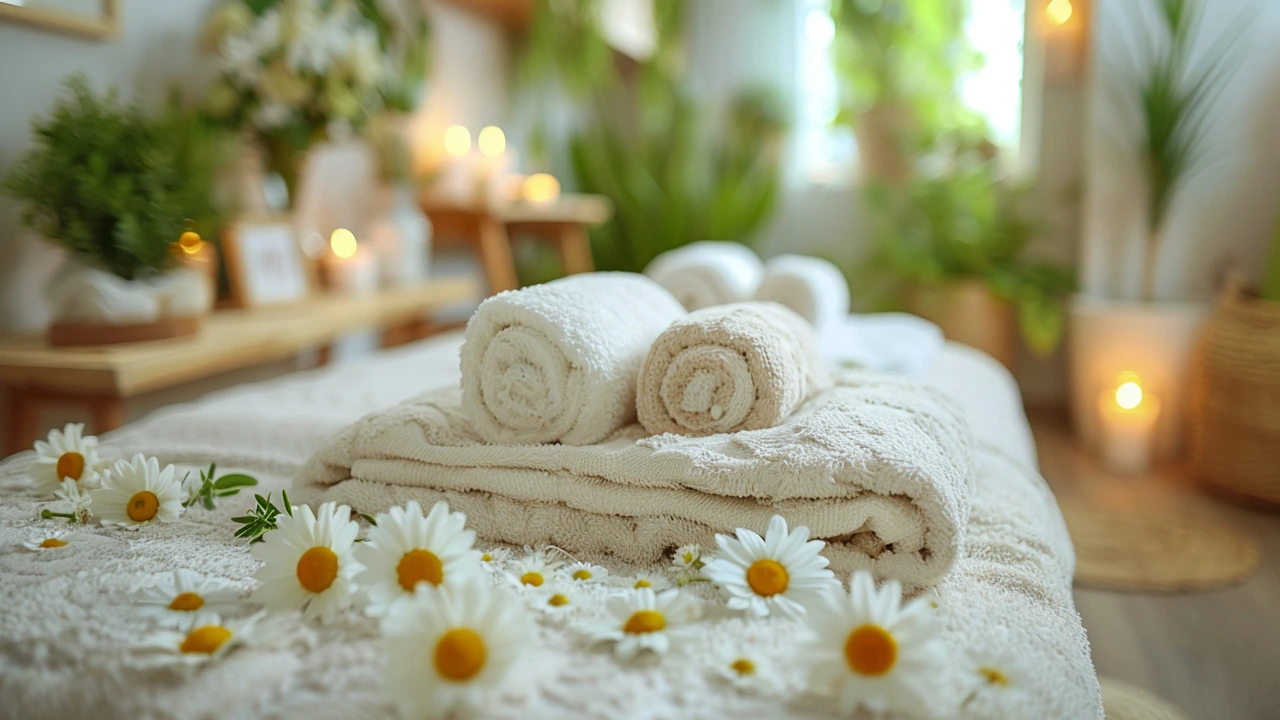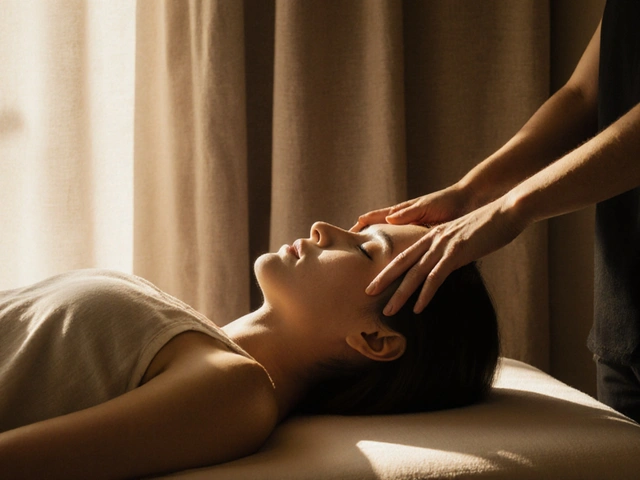Palliative Massage: Transforming Holistic Health and Wellbeing

Palliative massage isn't just a trend; it’s a significant shift in how we approach health and wellbeing. Rooted in the desire to enhance quality of life, this form of massage can be transformative for those in need.
Imagine dealing with chronic pain every day. Now, imagine a technique that can ease that burden, even if just a little bit. Palliative massage aims to do exactly that. It's not just about the physical relief; it's about giving patients a sense of comfort and peace.
From improving circulation to boosting mood, the benefits are substantial. And what's fascinating is that studies have shown how effective it can be in reducing symptoms of anxiety and depression. By simply using gentle techniques, therapists can help alleviate a lot of anguish and stress.
So, what makes it work? It's not magic; it's the blend of touch, empathy, and skill. Techniques often involve light, rhythmic strokes that focus on the patient's comfort level. It’s not only about applying pressure but knowing where and how to connect with the person.
- Understanding Palliative Massage
- Health Benefits and Psychological Impacts
- Techniques and Best Practices
- Real-Life Experiences and Stories
Understanding Palliative Massage
Palliative massage is a specially designed type of massage therapy that focuses on providing comfort, reducing pain, and improving the well-being of individuals facing severe chronic illnesses or end-of-life situations. Unlike traditional massage which often targets muscles to relieve tension, palliative massage centers on the patient’s overall comfort and emotional state.
This method isn't a substitute for medical treatment but a complementary therapy aimed at enhancing the patient's quality of life. The technique involves gentle, soothing movements that help in alleviating symptoms such as muscle tension, stress, anxiety, and even certain side effects of medical treatments like chemotherapy. In fact, palliative massage is increasingly being integrated into hospice and palliative care programs across the globe due to its proven benefits.
One of the major aspects of palliative massage is its ability to foster a sense of connection and trust. This is particularly significant as patients often feel isolated or disconnected during their illness journey. Skilled therapists are trained not only in the physical techniques but also in providing empathy, listening, and understanding, which are crucial elements in this therapy.
According to the American Massage Therapy Association, “Massage therapy can have a profound impact on the mood, physical symptoms, and levels of anxiety and depression in patients.”
Another striking feature is the flexibility of this therapy. The approach can be tailored to meet the unique needs of each patient. For instance, a patient with severe pain might benefit from light touch and rhythmic strokes that gently soothe their aches, whereas someone dealing with anxiety may find relief through more extensive relaxation techniques. Palliative massage isn’t one-size-fits-all but rather an adaptable practice.
Scientific studies support its efficacy, showing that palliative massage can significantly reduce pain levels, improve sleep quality, and enhance emotional health. For example, a study published in the Journal of Palliative Medicine found that patients receiving regular palliative massage reported substantial improvements in their physical and emotional symptoms compared to those who did not.
How It Works
The techniques used in palliative massage often involve gliding strokes, gentle kneading, and light touch. These actions work to stimulate the body’s natural relaxation response, setting a chain reaction of positive outcomes throughout the body and mind. Increased endorphin levels, improved blood circulation, and a calmer nervous system are just a few results of this therapy.
Equipment plays a role too. While some massages may involve oils or lotions to aid in smooth movements and hydration of the skin, others may use essential oils to incorporate the benefits of aromatherapy. The environment is also crafted to be as calming as possible, with soft lighting, peaceful music, and a warm, comfortable space to create an atmosphere of tranquility.
The goals of palliative massage are clear: ease physical discomfort, nurture emotional well-being, and offer a touch of human connection in often difficult times. It isn’t about curing but caring, tending to the holistic needs of the individual.

Health Benefits and Psychological Impacts
Palliative massage offers a wide range of health benefits, especially for individuals experiencing serious illnesses or undergoing palliative care. One of the main benefits is pain relief. The gentle touch used in palliative massage helps to stimulate endorphin production, which can naturally reduce the sensation of pain. Individuals have reported lower pain levels after just a few sessions, highlighting how effective this approach can be.
Besides pain relief, palliative massage improves circulation. Proper blood flow is essential for healing and overall health. Enhanced circulation helps deliver more oxygen and nutrients to tissues and organs. This can be especially beneficial for patients with illnesses that impair blood flow or those who are bed-bound for long periods.
The psychological impacts are just as significant as the physical benefits. Palliative massage helps alleviate anxiety and depression. The human touch involved in this practice fosters a sense of connection and community, which can significantly uplift a patient's mood. Studies show that frequent therapeutic touch can decrease cortisol levels, a hormone directly related to stress. When patients feel less stressed, their overall mental health improves substantially.
A noteworthy component of these psychological benefits is the reduction in feelings of isolation. Many people dealing with chronic illnesses spend extended periods alone. Receiving a massage can break this cycle and introduce positive, healing social interactions. The simple act of being touched and cared for can bring immense comfort and emotional stability.
As Dr. Mark Hyman aptly puts it, "Touch is a fundamental aspect of human connection, and its power in healing should not be underestimated."
Interestingly, research has highlighted how palliative massage can improve sleep patterns. Many chronic conditions are accompanied by sleep disturbances, and regular massage can help regulate sleep cycles. Better sleep improves both mental alertness and physical energy levels, creating a positive feedback loop of wellbeing.
Palliative massage has also been shown to boost the immune system. Regular sessions can increase the activity of white blood cells, which play a crucial role in defending the body against illness. This is incredibly valuable for patients whose immune systems are compromised due to their primary illnesses or treatments like chemotherapy.
A study published in the Journal of Palliative Care found a significant decrease in nausea and fatigue among cancer patients who received regular palliative massages. These benefits illustrate how much of a game-changer this practice can be for people dealing with severe health challenges.

Techniques and Best Practices
Palliative massage revolves around the principles of providing comfort and alleviating pain. One of the most fundamental techniques used is the gentle, rhythmic stroking of muscles. This not only helps in easing muscle tension but can also improve blood circulation. Therapists often use oils or lotions to make their strokes smoother and more soothing. This technique alone can make a huge difference in how a patient feels physically.
Another key method is known as effleurage, which involves long, gliding strokes towards the heart. This is particularly beneficial for improving lymphatic drainage. By assisting the lymphatic system, therapists help reduce fluid retention and enhance immune function. Effleurage is often used at the beginning and end of a session to relax the patient and ensure they are comfortable.
Then there's the technique of petrissage, characterized by kneading and squeezing the muscles. This method targets deeper muscle layers and is effective in relieving pain. Light petrissage can be comforting for patients who have tender or sensitive areas. It is important for therapists to gauge the patient's discomfort threshold to ensure the massage is beneficial rather than painful.
In addition to these, some therapists incorporate gentle stretching into their sessions. Stretching can increase mobility in stiff joints and relieve muscle tightness. It is particularly useful for patients who spend long hours in bed. By improving flexibility, therapists can help patients regain some independence in their movement.
Regular massage sessions are essential for patients to experience continuous relief and improvement. It’s recommended that sessions are held at least once a week. However, the frequency may vary based on the individual needs of the patient. It's crucial for therapists to listen to feedback and adjust their techniques accordingly.
Effective palliative massage also relies on a strong understanding of the patient's medical history. Therapists should collaborate with healthcare providers to ensure the massage techniques are safe and appropriate. This holistic approach ensures that all aspects of a patient's health are taken into account, resulting in a more effective therapy session.
Incorporating breathing exercises can amplify the benefits of palliative massage. As therapists work on muscle relaxation, they can guide patients through deep-breathing techniques. This can lower stress levels and create a more serene experience. Research shows that controlled breathing can reduce symptoms of anxiety and improve overall emotional wellbeing.
It’s worth noting that even the environment in which the massage takes place can impact its efficacy. A calm, quiet room with soft lighting and gentle music can make a significant difference. These elements help create a serene atmosphere, helping patients feel at ease and more open to the therapeutic process.
"Massage therapy can provide relief not only physically, but emotionally and spiritually," said Dr. Maria Hernandez, a noted palliative care specialist. "It’s a holistic practice that comforts the body and soul."
A tool often used during these sessions is a warm towel or hot pack. Applying warmth to tense areas can boost blood flow and relieve muscle knots. For patients with conditions like arthritis, the heat can provide lasting comfort and ease their daily pain.

Real-Life Experiences and Stories
Stories bring statistics to life and make abstract ideas concrete. With palliative massage, the anecdotes and real-life experiences of individuals can be especially compelling. Anne, a 67-year-old woman fighting metastatic breast cancer, found solace in palliative massage. For Anne, the pain and anxiety were overwhelming. Through the tender touch and rhythmic strokes of her massage therapist, she was able to find relief. She shared that the sessions were a sanctuary where she could feel human again, even if just for a brief period.
Another profound story comes from Michael, a young man diagnosed with amyotrophic lateral sclerosis (ALS). What initially seemed like a daunting journey soon unveiled moments of peace thanks to regular massage therapy. Michael mentioned that the massages didn’t only alleviate physical discomfort but also provided emotional nourishment. He could reconnect with a part of himself that often felt lost in the maze of his illness. These sessions allowed Michael to achieve a rare kind of calm, providing both him and his family with much-needed respite.
A study conducted by the American Massage Therapy Association (AMTA) found that about 70% of patients receiving palliative care reported a decrease in pain and an improvement in mood after regular massage sessions. This isn’t just about numbers; it's about real improvements in quality of life.
Even therapists have compelling stories. Jessica, a licensed massage therapist, recounted her work with dementia patients. She shared that the first objective is always to create a connection. Jessica uses gentle touch and soothing movements to communicate care and compassion. Over time, the touch often triggers memories, bringing a spark of recognition to her clients' eyes. It’s a profoundly human form of interaction that bypasses verbal communication.
Such testimonials aren’t just feel-good stories; they highlight the real impact of palliative massage. These experiences remind us that success in palliative care isn't always about combating illness but about enhancing the quality of life. In cases where recovery might not be an option, creating moments of joy and comfort makes all the difference.“Touch is a language older than words,” says Dr. Tiffany Field, Director of the Touch Research Institute. “It has the potential to provide profound comfort and solace, especially in challenging times.”
Lastly, a touching tale comes from a children's hospice where massage therapy has been integrated into the care plan. Young Ethan, who battled a rare genetic disorder, looked forward to his sessions with pure excitement. These moments allowed him to express joy and feel free from tubes and clinical settings. His mother shared that Ethan seemed like a different child afterward, calmer and more content. She believes these sessions significantly improved Ethan's short life, giving him fragments of normalcy and happiness.
These stories, both heart-wrenching and uplifting, show the importance of palliative massage. They are a testament to the profound impact it can have on those in need. By sharing these narratives, we hope to demystify this practice and highlight its remarkable benefits. Palliative massage is more than just a treatment; it's a bridge to connection, comfort, and humanity.





